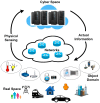Network challenges for cyber physical systems with tiny wireless devices: a case study on reliable pipeline condition monitoring
- PMID: 25815444
- PMCID: PMC4431241
- DOI: 10.3390/s150407172
Network challenges for cyber physical systems with tiny wireless devices: a case study on reliable pipeline condition monitoring
Abstract
The synergy of computational and physical network components leading to the Internet of Things, Data and Services has been made feasible by the use of Cyber Physical Systems (CPSs). CPS engineering promises to impact system condition monitoring for a diverse range of fields from healthcare, manufacturing, and transportation to aerospace and warfare. CPS for environment monitoring applications completely transforms human-to-human, human-to-machine and machine-to-machine interactions with the use of Internet Cloud. A recent trend is to gain assistance from mergers between virtual networking and physical actuation to reliably perform all conventional and complex sensing and communication tasks. Oil and gas pipeline monitoring provides a novel example of the benefits of CPS, providing a reliable remote monitoring platform to leverage environment, strategic and economic benefits. In this paper, we evaluate the applications and technical requirements for seamlessly integrating CPS with sensor network plane from a reliability perspective and review the strategies for communicating information between remote monitoring sites and the widely deployed sensor nodes. Related challenges and issues in network architecture design and relevant protocols are also provided with classification. This is supported by a case study on implementing reliable monitoring of oil and gas pipeline installations. Network parameters like node-discovery, node-mobility, data security, link connectivity, data aggregation, information knowledge discovery and quality of service provisioning have been reviewed.
Figures













References
-
- Akyildiz I.F., Su W., Sankarasubramaniam Y., Cayirci E. Wireless Sensor Networks: A Survey. IEEE Comput. J. 2002;38:393–422.
-
- Dargie W., Poellabauer C. Fundamentals of Wireless Sensor Networks: Theory and Practice. Volume 191. John Wiley & Sons, Ltd; New York, NY, USA: 2010. pp. 168–183.
-
- Shi J., Wan J., Yan H., Suo H. A Survey of Cyber-Physical Systems; Proceedings of the 2011 International Conference on Wireless Communications and Signal Processing (WCSP); Nanjing, China. 9–11 November 2011; pp. 1–6.
-
- Daneels A., Salter W. SCADA Systems for the Controls of the CERN LHC Experiments; Proceedings of the International Conference on Accelerator and Large Experimental Physics Control Systems; Trieste, Italy. 4–8 October 1999; pp. 353–355.
-
- Pires M., Oliveira P.S. Security Aspects of SCADA and Corporate Network Interconnection: An Overview; Proceedings of the International Conference on Dependability of Computer Systems; Szklarska Poreba, Poland. 25–27 May 2006; pp. 127–134.
Publication types
LinkOut - more resources
Full Text Sources
Other Literature Sources

